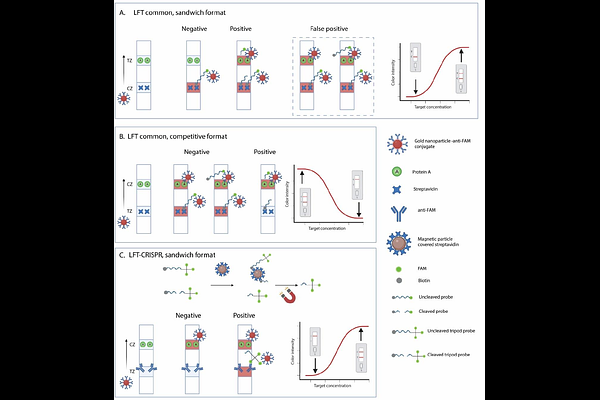A novel tripod probe and lateral flow test to improve CRISPR/Cas12a assay: benefits of branched probe based on trebler phosphoramidite modification

A novel tripod probe and lateral flow test to improve CRISPR/Cas12a assay: benefits of branched probe based on trebler phosphoramidite modification
Safenkova, I. V.; Kamionskaya, M. V.; Ivanov, A. V.; Zherdev, A. V.; Dzantiev, B. B.
AbstractCRISPR/Cas12a-based assays, when integrated with lateral flow tests (LFTs), provide highly specific nucleic acid detection in a simple, rapid, and equipment-free format. Nevertheless, traditional DNA probes utilized for cleavage by Cas12a have notable limitations as the cleaved probe only has one label. To overcome this challenge, we engineered a novel type of DNA probe with multiple fluorescein (FAM) labels and a biotin-labeled single-stranded DNA fragment (polyFAM probe). The cleaved polyFAM parts of probes were detected using a specially designed sandwich LFT, where FAM-specific antibodies were immobilized in the test zone and conjugated with gold nanoparticles. The LFT ensured accurate recognition of the cleaved polyFAM fragments within 10 minutes. A comparison of five distinct polyFAM probes revealed that the highest signal-to-noise ratio was achieved with a tripod-branched probe synthesized via trebler phosphoramidite modification. Each arm of the tripod probe consists of a hexaethylene glycol spacer ending in a FAM label. Upon Cas12a cleavage, the tripod structure carrying three FAMs is released and detected by LFT. A rapid magnetic separation strategy was subsequently implemented, facilitating the efficient removal of uncleaved probes via biotin-streptavidin capture within 5 minutes. The CRISPR/Cas12a-tripod-LFT strategy demonstrated excellent sensitivity without preamplification, with a detection limit of 1.4 pM for DNA target of Salmonella Typhimurium. The CRISPR/Cas12a-tripod-LFT with preliminary loop-mediated isothermal amplification enabled the detection of as few as 0.3 cells per reaction. This innovative tripod probe with corresponding LFT creates a universal, sensitive, rapid, and equipment-free biosensing platform for CRISPR/Cas12a-based diagnostics in point-of-care applications.